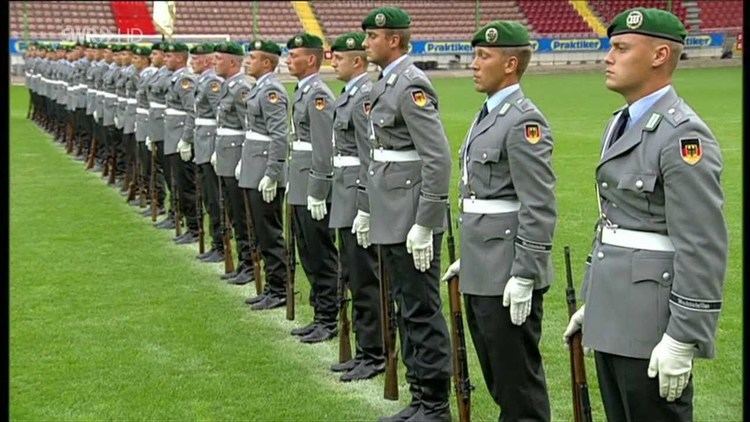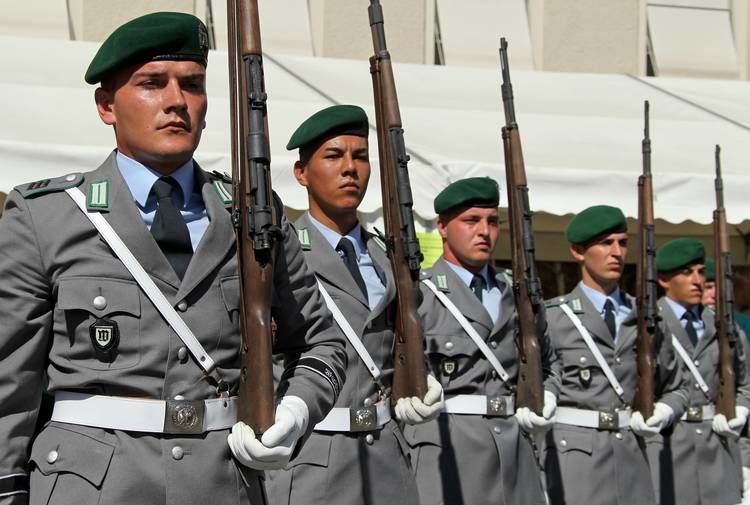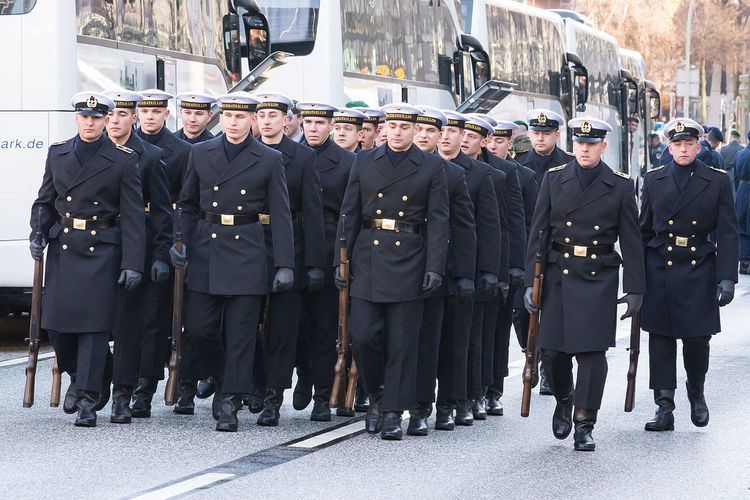Country Germany Founded 1957 | Size 7 active companies | |
Active 15 February 1957 - Present Role Drill, ceremonial and guarding and security duties Motto Semper talis (always the same/great) Similar Joint Support Service, Bundeswehr, German Army, German Air Force, German Army Aviation | ||
Drillteam der 5 wachbataillon 2005 in kanada
The Wachbataillon (full name: Wachbataillon beim Bundesministerium der Verteidigung (WachBtl BMVg) (Guard battalion at the Ministry of Defence)) is the German Bundeswehr's elite drill unit. The Wachbataillon is the largest battalion of the German forces with about 1,000 soldiers in Berlin. It consists of seven active companies (see list below) and belongs to the Streitkräftebasis (Joint Service Support Command) of the Bundeswehr. The soldiers of the Wachbataillon often refer to themselves as Protter or Protokollsoldaten, meaning protocol soldiers.
Contents
- Drillteam der 5 wachbataillon 2005 in kanada
- Bundeswehr wachbataillon drill team mit karabiner 98k
- Mission
- Recruitment
- Equipment
- Tradition
- Structure
- References

Bundeswehr wachbataillon drill team mit karabiner 98k
Mission

The primary mission of the Wachbataillon is to perform the military honours for the German president, the German Chancellor, the Federal Minister of Defence and the Inspector General of the Bundeswehr during state visits or on comparable occasions.

In addition the Wachbataillon executes the Großer Zapfenstreich on special occasions (for example on the 50th anniversary of the Bundeswehr in front of the Reichstag in Berlin on the night of October 26, 2005) or takes part in (inter)national events like the ceremonial oath of the Bundeswehr ceremony, parades, state funerals, military tattoos and shows with its drill team which is the best trained special unit of the battalion.
A secondary mission is to perform (ceremonial) guard duty at the Ministry of Defence and other high-profile public places and protect and guard the members of the German government and the Ministry of Defence.
An additional secondary mission is securing and defending the alternate seat of the federal German government in conjunction with forces of the Federal Police. Therefore, all soldiers of the Wachbataillon trained as infantrymen and do regular exercises on military training areas (Truppenübungsplatz) in addition to their protocol duties.
Recruitment
Until recently, the Wachbataillon protocol- and security companies only admitted male personnel that had a body height ranging from 1.79 meters (5 ft 10 in) up to 1.93 meters (6 ft 4 in), normal eyesight and body weight and are generally in good health. Wachbataillon personnel (especially protocol soldiers) still are not allowed to grow beards or moustaches as well as wearing Glasses or having Overweight (Bierbauch). These are the internal so called "vorbidden three B's" ("verbotene drei Bs - keine Brille, kein Bart, kein Bauch").
Since 2009 the 1./WachBtl BMVg staff- and supply company has started to admit female personnel. In the Großer Zapfenstreich for Karl-Theodor zu Guttenberg in March 2011, the first female soldier was performing the role of torchbearer. Until the end of conscription in Germany in July 2011, about 80 percent of Wachbataillon's personnel were conscripts. The requirements for Wachbataillon personnel where relaxed to a body height ranging from 1.75 meters (5 ft 9 in) up to 2.00 meters (6 ft 7 in), no visible visual aids and having a good general fitness. In March 2012 the first female officer took command of a platoon of the Wachbataillon.
The soldiers of the Wachbataillon are from all three German Armed Services (i.e. Army, Navy and Air Force) and have the uniforms from all forces at their disposal to be able to perform any drill mission on every occasion. Green berets are used for Army uniform, the (dark) blue beret for Air Force and the Navy wears traditionally the sailor suit (Matrosenanzug). The beret badge for Army and Air Force uniform shows the letter "W" as an abbreviation for Wachbataillon.
Equipment
For reasons of tradition the Wachbataillon is the only unit of the Bundeswehr still using the Karabiner 98k because the traditional Prussian rifle drills can be executed better with that historical weapon. In 1995 remaining swastikas and other Nazi-era markings were removed from these rifles, after criticism regarding the presence of such symbols on Wachbataillon kit by the SPD parliamentary party. As of 29 October 2011 women are allowed to attain the demanding drill training with the Karabiner 98k rifle.
During normal day duty the Wachbattalion uses the Heckler & Koch G36 assault rifle and other kit like the other units of the Bundeswehr. Since 2006 the 1./WachBtl BMVg is the last unit in the Bundeswehr using ten Feldhaubitze 105 mm guns in the role of salute guns.
The silent drill team of The Citadel, The Summerall Guards, models its close-order drill routine after Wachbataillon's.
Tradition
The Wachbataillon has been granted exemption of the Traditionserlass and is thus continuing the traditions of the 1st Foot Guards and the Infantry Regiment 9 Potsdam, the only unit in the Bundeswehr to have such ties. Veterans of these regiments are joined with active and former members of the Wachbataillon in the Semper Talis Union.
Structure
The Wachbataillon with its required strength of 1,033 soldiers has actually regimental strength, but it remains a battalion sized formation in name. It is stationed at the Julius Leber barracks in the center of Berlin. Since 2001 the Wachbataillon is part of the Streitkräftebasis. The battalion is organized into seven active companies (four of them honor guard companies) and additionally 2 inactive military reserve companies.
